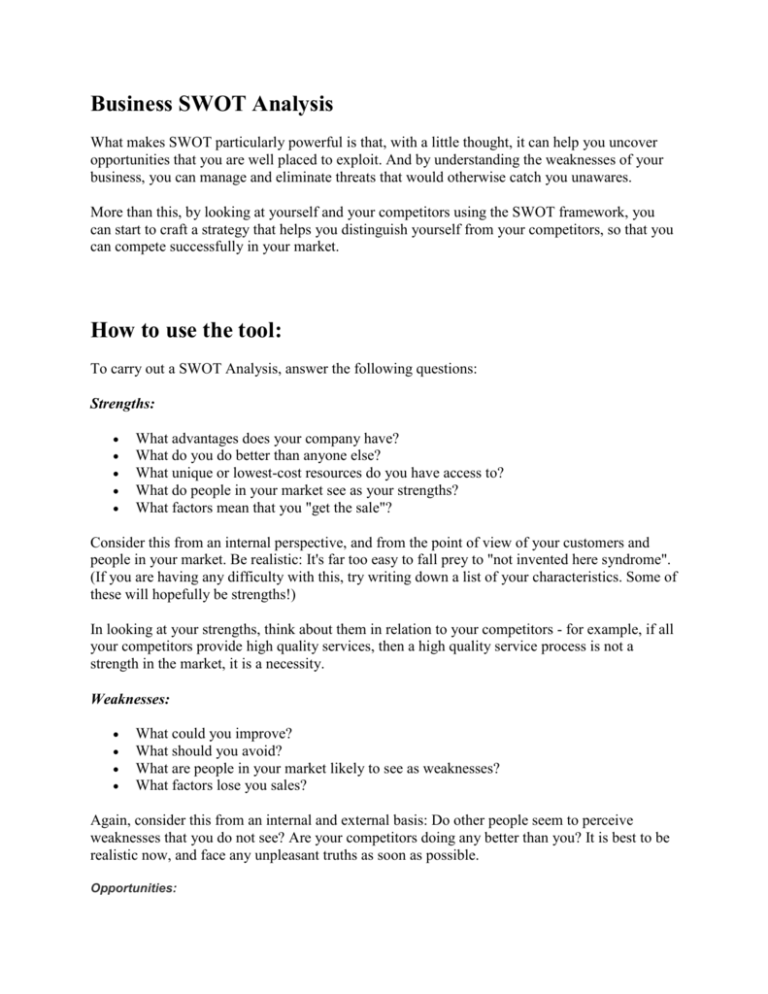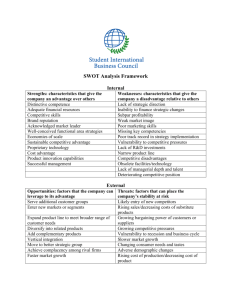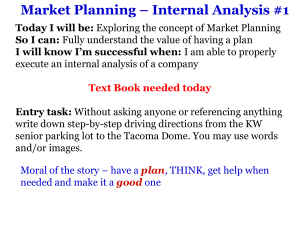SWOT Analysis - Overview - MidWest Clinicians' Network
advertisement

Business SWOT Analysis What makes SWOT particularly powerful is that, with a little thought, it can help you uncover opportunities that you are well placed to exploit. And by understanding the weaknesses of your business, you can manage and eliminate threats that would otherwise catch you unawares. More than this, by looking at yourself and your competitors using the SWOT framework, you can start to craft a strategy that helps you distinguish yourself from your competitors, so that you can compete successfully in your market. How to use the tool: To carry out a SWOT Analysis, answer the following questions: Strengths: What advantages does your company have? What do you do better than anyone else? What unique or lowest-cost resources do you have access to? What do people in your market see as your strengths? What factors mean that you "get the sale"? Consider this from an internal perspective, and from the point of view of your customers and people in your market. Be realistic: It's far too easy to fall prey to "not invented here syndrome". (If you are having any difficulty with this, try writing down a list of your characteristics. Some of these will hopefully be strengths!) In looking at your strengths, think about them in relation to your competitors - for example, if all your competitors provide high quality services, then a high quality service process is not a strength in the market, it is a necessity. Weaknesses: What could you improve? What should you avoid? What are people in your market likely to see as weaknesses? What factors lose you sales? Again, consider this from an internal and external basis: Do other people seem to perceive weaknesses that you do not see? Are your competitors doing any better than you? It is best to be realistic now, and face any unpleasant truths as soon as possible. Opportunities: Where are the good opportunities facing you? What are the interesting trends you are aware of? Useful opportunities can come from such things as: Changes in technology and markets on both a broad and narrow scale Changes in government policy related to your field Changes in social patterns, population profiles, lifestyle changes, etc. Local events A useful approach for looking at opportunities is to look at your strengths and ask yourself whether these open up any opportunities. Alternatively, look at your weaknesses and ask yourself whether you could create opportunities by eliminating them. Threats: What obstacles do you face? What is your competition doing that you should be worried about? Are the required specifications for your job, products or services changing? Is changing technology threatening your position? Do you have bad debt or cash-flow problems? Could any of your weaknesses seriously threaten your business? Carrying out this analysis will often be illuminating - both in terms of pointing out what needs to be done, and in putting problems into perspective. Strengths and weaknesses are often internal to your organization. Opportunities and threats often relate to external factors. For this reason the SWOT Analysis is sometimes called InternalExternal Analysis and the SWOT Matrix is sometimes called an IE Matrix Analysis Tool. You can also apply SWOT Analysis to your competitors. As you do this, you'll start to see how and where you should compete against them. Tip: SWOT can be used in two ways - as a simple icebreaker helping people get together and "kick off" strategy formulation, or in a more sophisticated way as a serious strategy tool. If you're using it as a serious tool, make sure you're rigorous in the way you apply it: Only accept precise, verifiable statements ("Cost advantage of US$10/ton in sourcing raw material x", rather than "Good value for money"). Ruthlessly prune long lists of factors, and prioritize factors so that you spend your time thinking about the most significant factors. Make sure that options generated are carried through to later stages in the strategy formation process. Apply it at the right level - for example, at product or product line level, rather than at the much vaguer whole company level. Supplement it with other option-generation tools - none is likely to be completely comprehensive.





